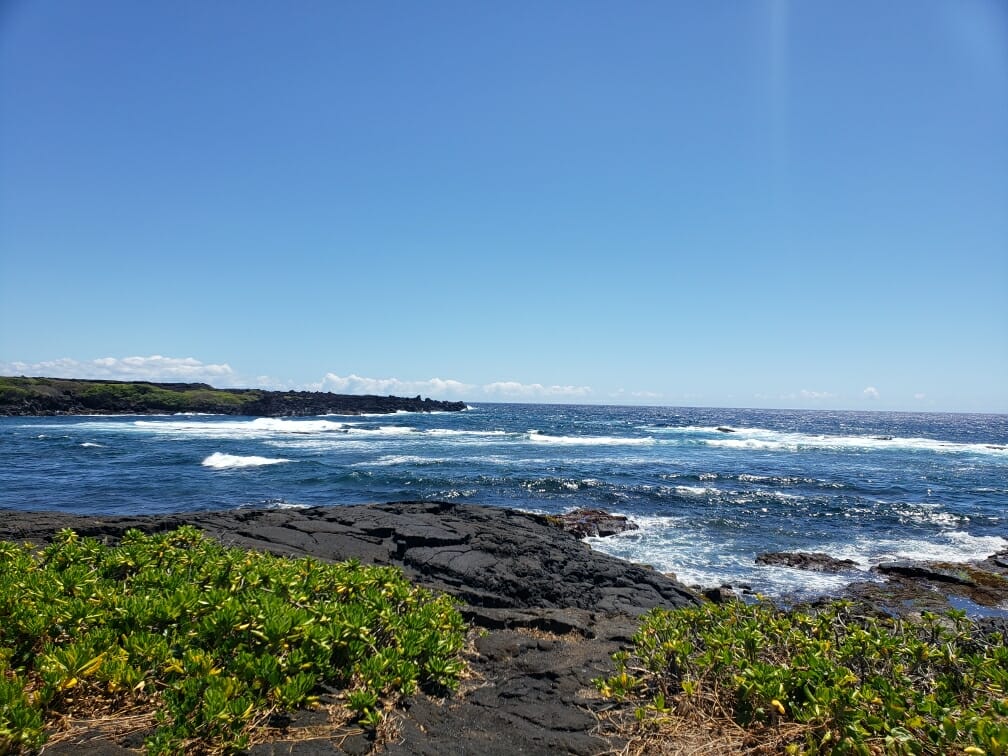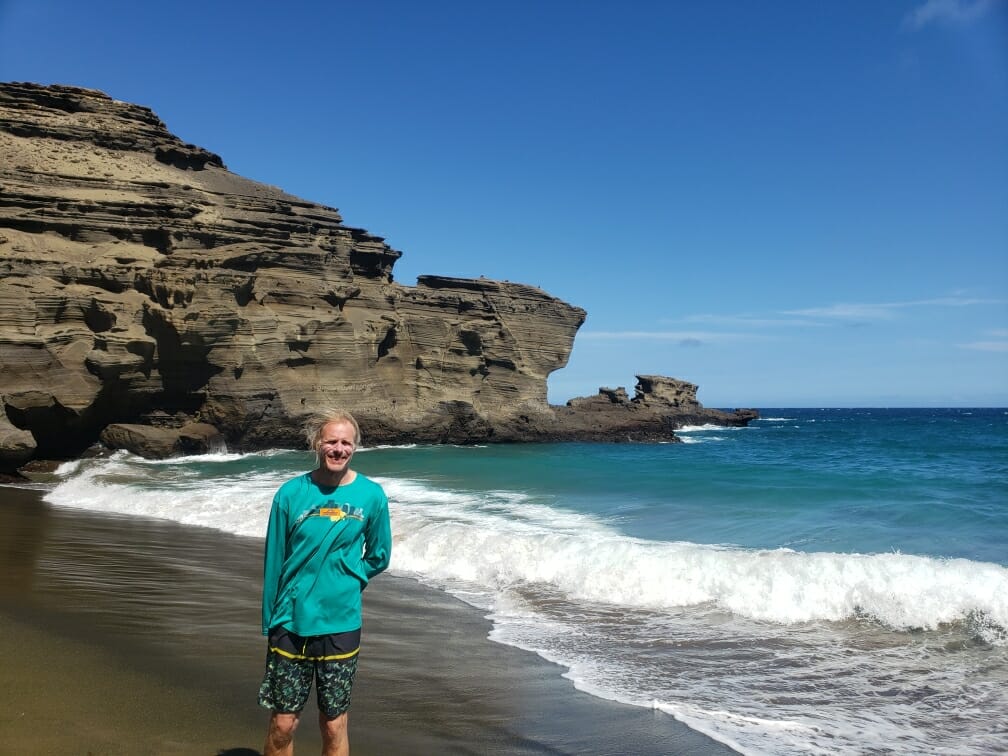
Zziiipppp.
Labor Day 2021, Kohala Coast, Big Island Hawaii, 6 a.m.
Careful not to awake others in camp, I opened the tent zipper with a purr, not a growl.
The sun rose over the campground at the beach. As I poked my head out the tent door, the view was phenomenal. The sea was still as glass. Pink, mauve and orange filled the sky, just like for sunset the previous night. Early morning would be the perfect time for kayaking before the wind kicked up.
Our campsite was directly on the beach amidst mesquite trees. Foraging pests were not the raccoons of the mainland east coast, but Indian mongoose, introduced in 1883 by the sugar industry to control rats. Red-crested cardinals (red head, white body, gray wings and tail) flitted and chattered among the mesquites. And just beneath the surface, directly past the shoreline, awaited a brightly-hued Technicolor coral reef dream teeming with tropical fish and invertebrate species.
I grabbed a paddle and launched a kayak.
My wife Charlotte and I had come to Hawaii to visit my stepson Stuart and his girlfriend Julianna. Our first trip, five years prior, featured some classic Hawaiian vacation experiences. Maybe not luaus, leis, mai tais and fire dancing, but at least white sand beaches lined by palm trees with coconuts. This itinerary called for a different experience. Off-the-beaten path. Departing beaches with white sand to explore those with black sand and green sand. Yes, green sand.
In Hilo, where Stuart and Julianna live, Richardson Beach Park and Carlsmith Beach Park, a.k.a. Four Mile, are wonderful. Our first morning on the island we visited Richardson. In a lagoon, we counted 13 green sea turtles lounging in the shallows. The snorkeling was great. I identified 30 species of fish over the week. And in the distance, across Hilo Bay, Mauna Kea, 13803’, was visible.

Later in the week, we visited Punalu’u Beach. On the south end of Hawaii, it features black sand derived from basalt, created when hot lava explodes upon hitting the cool ocean water. There are two main types of flow lava-a’a and pahoehoe. One thing I have learned about lava morphology, the latter, pahoehoe, is easier to walk on in a pair of Olukais. It is formed from fluid flow hardening into smooth, ropy rock. A’a is formed from more viscous flow, creating sharp, loose rocks contributing to uneven footing. As I scampered across the cliffs overlooking Punalu’u, I had to be careful on the a’a with the waves crashing below.
Punalu’u is removed from the honeymoon resorts of Kailua-Kona. Key West is the southernmost town in the U.S. right? Eh, not so fast. The remote town of Na’alehu, near Punalu’u, actually is. Key West holds the distinction just for the contiguous 48. Before heading on to the next beach, we made a pit stop at the Punalu’u Bake Shop in Na’alehu. The attraction here was a box of coconut, strawberry and mango malasadas. A malasada is a sugar-dusted or glazed, deep-fried, filling-stuffed Portuguese doughnut. Later that day, just to make sure I had achieved my required daily sugar intake, I drank a Hawaiian Sun Lilikoi Passionfruit drink.
Next up, Papakōlea. How is this for a unique beach experience? You park, make sure you have plenty of drinking water, slather the reef-safe sunscreen on thick, and commence on a 2 ½ mile hike. You hike through pastureland abutting the sea along rocky, volcanic coast. The trail is dusty. The sun blazes and you find no shade, but a sea breeze keeps you cool. The beachcombing is interesting and you find a
cowrie shell. As you get close to your destination, a promontory becomes visible in the distance, signifying your reward (Alright, I know this is not for everyone). Then when you reach the beach where you will swim, the scenery fantastic, you notice the sand has a subtle olive coloring. Guess who else is here? Honu. A green sea turtle is frolicking in the gentle surf, but there are very few humans. Welcome to , Papakōlea one of four of the world’s green sand beaches.
The mineral olivine gives the sand here its green color. After our trip, Charlotte and I are considering enrolling in the University of Hawaii-Hilo to study volcanology, but until we are accepted into the program, here is my interpretation of the science at the Green Sand Beach. About 50,000 years ago, a cinder cone, Mahana, was created by a Mauna Loa eruption. At some point, this type of cinder cone, known as a tuff ring, partially collapsed, allowing the sea to erode the rock. Over time, deposited olivine crystals have been freed by wave action. These denser crystals remain on the beach, whereas less dense sand has been sluiced out to sea.

After our beach excursions, our adventures took us to Hawaii Volcanoes National Park.
We had visited here in 2016. As we drove through fee collection back then, the stench of sulfur hit us. Signs warned folks with respiratory ailments. From a visitor center overlook, we eyed pooled lava glowing in the Halema’uma’u Crater on Kilauea. On the observation platform, a group of Hawaiian children performed traditional song.
Fast forward to May 2018. Lava burst from vents miles from the caldera. Over 700 buildings were destroyed. The caldera drained into the cone. An explosion belched ash 30,000 ft. into the atmosphere. Our favorite snorkeling spot from two years prior, the Kapoho tide pools, was buried by molten flow. The eruption did not end until September of that year. One of Stuart and Julianna’s friends still has steam venting from a crack in the yard.
By the time of this 2021 visit, Kilauea had been pretty quiet for three months. We arrived from the Green Sand Beach in the evening. This night, we enjoyed the luxury of a camping cabin. Devoid of light pollution, the celestial sky was fabulous. The following morning we enjoyed a few short nature walks. One gave us a view of Mauna Loa, 13,679’. Another, Kipukapualu “Bird Park” transported us through Hawaiian rainforest. I kept my eyes peeled for honeycreepers, yellow and scarlet jewels in flight, which feed on nectar. Perhaps I caught I glimpse of an i’iwi or an apapane, but the elusive bird quickly flew off. I love the old-growth tulip poplar grove of Joyce Kilmer/Slickrock in NC. Here we walked through very different old-growth forest, yet with some similarities, populated instead by native koa and ohi’a trees.
During the week we were treated to a Hawaiian foodie fest. This is partly thanks to unusual eats available on the island. For example, after a kayak trip around Hilo Bay, I indulged in a creamy lychee Popsicle. But also credit to the fact that Stuart and Julianna are amazing cooks, culinary wizards of both front country and backcountry. Packing lunch for a beach day in NC means assembling a turkey sandwich. Beach lunch made by Julianna was a sushi rice ball wrapped in nori seaweed with a poke ahi tuna core. In 2018, while Kilauea erupted, they lived the van life in Australia. They noticed campers cooking with jaffle irons over open fires and followed suit, At GOPC, we know jaffle irons as Rome pie irons. Stuart demonstrated how to employ this hinged cast iron implement in the preparation of gustatory delights-Paninis, pesto veggie grilled cheese and burritos.

We were constantly reminded of the fragility of Hawaiian ecosystems. Immediately upon deplaning, we heard the sound of coqui frogs. From dusk to dawn their loud, incessant call can be heard. Julianna, who grew up on Hawaii, remembers nights without this cacophony. An invasive species, they have no natural predators here and their numbers have soared to twice the population density found in their native Puerto Rico. Mongoose prey on the eggs and hatchlings of eight endangered Hawaiian birds. Feral cat urine running into the sea causes fatal toxoplasmosis in the critically-endangered Hawaiian monk seal. We noticed lesions on the face of a green sea turtle. This is fibropapillomatosis. The disease is associated with highly-polluted coastal areas. Upon entering Kipukapualu, we brushed loose dirt off of our hiking shoes and sprayed the soles with an alcohol solution. The reason-ROD-Rapid Ohi’a Death. A fungal pathogen attacks the ohi’a trees. Koa trees are adversely affected by a non-endemic vine. While snorkeling, our party observed a crown of thorns starfish. This starfish causes significant coral damage and is one of the reasons for decline of the Great Barrier Reef.
Malama ‘Aina. I left Hawaii with a palpable realization. By and large, the people of Hawaii love and respect the natural beauty and magic of their island. Malama ‘Aina means to care for and nurture the land. The daunting conservation and impending extinction issues were partially assuaged by actions I saw from Stuart and Julianna, their coterie of friends and the native Hawaiians. They hold values consistent with preserving their precious home and deeply appreciate the need for a sustainable future. One of their friends, Ellen, who we camped with, is an entomologist who has come to Hawaii tasked with controlling invasive species. After the week, I left with a stronger feeling of environmental responsibility.
Almost 9 a.m. on Labor Day 2021.
The sun was up. Across the Alenuihaha Channel, I could see Haleakala on Maui. The long-extinct Kohala volcano, was kissed by morning sunlight in front of me. I sat atop the kayak, exploring coves along the shoreline. I was lulled into a peaceful, euphoric feeling by the slapping of waves on the hull, the magnitude of the scenery, the meditative quality of the paddle stroke and the redolence of the salt air. Coming back, I could see flags draped aside a campmate’s ENO hammock. Everybody was awake. The end of the kayaking session coincided with breakfast. I had worked up an appetite. Stuart was scrambling eggs with three kinds of cheese on the single burner, browning hash browns with the jaffle iron, peeling and slicing avocados from his garden and readying Kona coffee for the French press.
Paradise.
